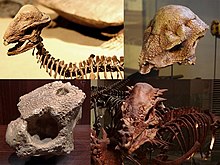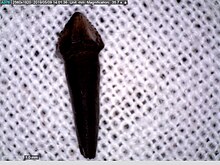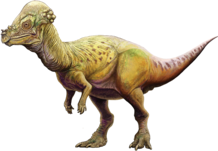
A | B | C | D | E | F | G | H | CH | I | J | K | L | M | N | O | P | Q | R | S | T | U | V | W | X | Y | Z | 0 | 1 | 2 | 3 | 4 | 5 | 6 | 7 | 8 | 9
| Pachycephalosaurs Temporal range: Late Cretaceous,
| |
|---|---|

| |
| Montage of four pachycephalosaurs. Clockwise from top left: Stegoceras, Prenocephale, Pachycephalosaurus and Homalocephale | |
| Scientific classification | |
| Domain: | Eukaryota |
| Kingdom: | Animalia |
| Phylum: | Chordata |
| Clade: | Dinosauria |
| Clade: | †Ornithischia |
| Clade: | †Neornithischia |
| Clade: | †Cerapoda |
| Clade: | †Marginocephalia |
| Clade: | †Pachycephalosauria Sternberg, 1945 (conserved name) |
| Type species | |
| †Pachycephalosaurus wyomingensis Gilmore, 1931 (conserved name)
| |
| Genera | |
| |
Pachycephalosauria (/ˌpækɪsɛfələˈsɔːriə, -ˌkɛf-/;[1] from Greek παχυκεφαλόσαυρος for 'thick headed lizards') is a clade of ornithischian dinosaurs. Along with Ceratopsia, it makes up the clade Marginocephalia. With the exception of two species, most pachycephalosaurs lived during the Late Cretaceous Period, dating between about 85.8 and 66 million years ago.[2] They are exclusive to the Northern Hemisphere, all of them being found in North America and Asia. They were all bipedal, herbivorous/omnivorous animals with thick skulls. Skulls can be domed, flat, or wedge-shaped depending on the species, and are all heavily ossified. The domes were often surrounded by nodes and/or spikes. Partial skeletons have been found of several pachycephalosaur species, but to date no complete skeletons have been discovered. Often isolated skull fragments are the only bones that are found.[3]
Candidates for the earliest-known pachycephalosaur include Ferganocephale adenticulatum from Middle Jurassic Period strata of Kyrgyzstan and Stenopelix valdensis from Early Cretaceous strata of Germany, although R.M. Sullivan has doubted that either of these species are pachycephalosaurs.[4] The oldest known pachycephalosaur is currently Sinocephale bexelli from the Late Cretaceous of China.[5] In 2017, a phylogenetic analysis conducted by Han and colleagues identified Stenopelix as a member of the Ceratopsia.[6]
Description
Pachycephalosaurs were bipedal ornithischians characterized by their thickened skulls. They had a bulky torso with an expanded gut cavity and broad hips, short forelimbs, long legs, a short, thick neck, and a heavy tail. Large orbits and a large optic nerve point to pachycephalosaurs having good vision, and uncharacteristically large olfactory lobes indicate that they had a good sense of smell relative to other dinosaurs.[3] They were fairly small dinosaurs, with most falling in the range of 2–3 meters (6.6–9.8 feet) in length and the largest, Pachycephalosaurus wyomingensis, estimated to measure 4.5 meters (14.8 feet) long and weigh 450 kilograms (990 pounds).[2][7] The characteristic skull of pachycephalosaurs is a result of the fusion and thickening of the frontals and parietals, accompanied by the closing of the supratemporal fenestra. In some species this takes the form of a raised dome; in others, the skull is flat or wedge-shaped. While the flat-headed pachycephalosaurs are traditionally regarded as distinct species or even families, they may represent juveniles of dome-headed adults.[4] All display highly ornamented jugals, squamosals, and postorbitals in the form of blunt horns and nodes. Many species are only known from skull fragments, and a complete pachycephalosaur skeleton is yet to be found.[3]
Members of Pachycephalosauria characteristically have an unusually domed head reminiscent of the earlier Protopyknosia in an example of convergent evolution.[8]
Classification

Most pachycephalosaurid remains are not complete, usually consisting of portions of the frontoparietal bone that forms the distinctive dome. This can make taxonomic identification a difficult task, as the classification of genera and species within Pachycephalosauria relies almost entirely on cranial characteristics. Consequently, improper species have historically been appointed to the clade. For instance, Majungatholus, once thought to be a pachycephalosaur, is now recognized as a specimen of the abelisaurid theropod Majungasaurus, and Yaverlandia, another dinosaur initially described as a pachycephalosaurid, has also since been reclassified as a coelurosaur (Naish in Sullivan (2006)). Further complicating matters are the diverse interpretations of ontogenetic and sexual features in pachycephalosaurs.
A 2009 paper proposed that Dracorex and Stygimoloch were just early growth stages of Pachycephalosaurus, rather than distinct genera.[9]
A 2020 reworking of Cerapoda by Dieudonné et al. recovered the animals traditionally considered 'heterodontosaurids' as a basal grouping within Pachycephalosauria, paraphyletic with respect to the traditional, dome-headed pachycephalosaurs.[10] The same conclusion had previously been reached by George Olshevsky in 1991, who classified heterodontosaurids as basal pachycephalosaurs on the basis of perceived cranial kinesis, the presence of fanglike premaxillary teeth, and the prominent diastema present in many genera.[11]
Taxonomy

The Pachycephalosauria was first named as a suborder of the order Ornithischia by Maryańska & Osmólska (1974). They included within it only one family, the Pachycephalosauridae.[12] Later researchers, such as Michael Benton, have ranked it as an infraorder of a suborder Cerapoda, which unites the ceratopsians and ornithopods.[13] In 2006, Robert Sullivan published a re-evaluation of pachycephalosaur taxonomy. Sullivan considered attempts by Maryańska and Osmólska to restrict the definition of Pachycephalosauria redundant with their Pachycephalosauridae, since they were diagnosed by the same anatomical characters. Sullivan also rejected attempts by Sereno (1986), in his phylogenetic studies,[14] to re-define Pachycephalosauridae to include only "dome-skulled" species (including Stegoceras and Pachycephalosaurus), while leaving more "basal" species outside that family in Pachycephalosauria. Therefore, Sullivan's use of Pachycephalosauridae is equivalent to Sereno and Benton's use of Pachycephalosauria.
Sullivan diagnosed the Pachycephalosauridae-based only on characters of the skull, with the defining character being a dome-shaped frontoparietal skull bone. According to Sullivan, the absence of this feature in some species assumed to be primitive led to the split in classification between domed and non-domed pachycephalosaurs; however, discovery of more advanced and possibly juvenile pachycephalosaurs with flat skulls (such as Dracorex hogwartsia) show this distinction to be incorrect. Sullivan also pointed out that the original diagnosis of Pachycephalosauridae centered around "flat to dome-like" skulls, so the flat-headed forms should be included in the family.[15] In a paper published in 2003, Thomas E. Williamson and Thomas D. Carr discovered a clade of the Pachycephalosauridae that was a sister taxa to the genus Stegoceras, made up of "all other dome-headed pachycephalosaurians; this was referred to as Pachycephalosaurinae[16]
Phylogeny
The cladogram presented here follows an analysis by Williamson & Carr (2002).[17]
| Pachycephalosauria |
| ||||||||||||||||||||||||
Cladogram after Longrich, Sankey & Tanke (2010).[18]


